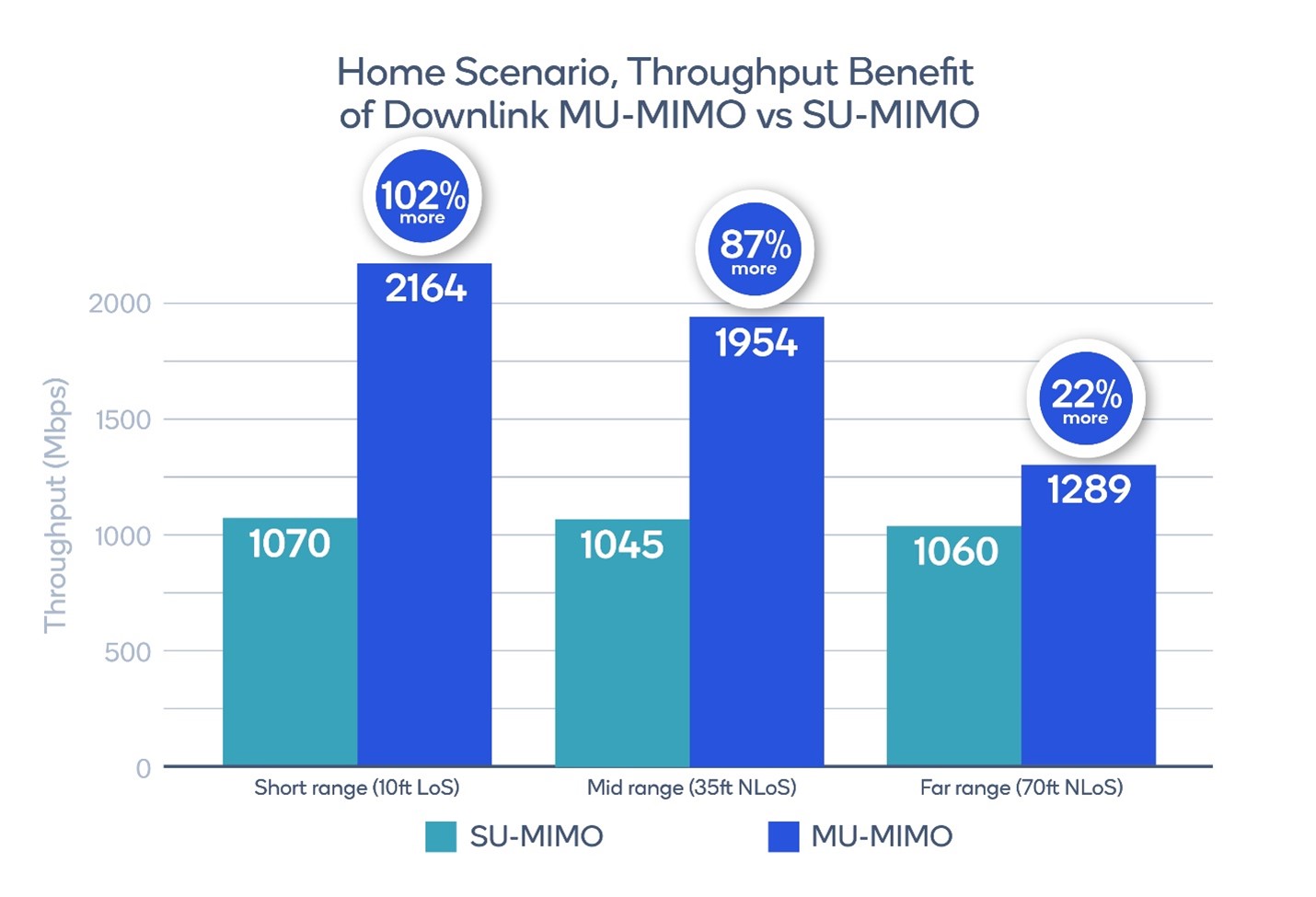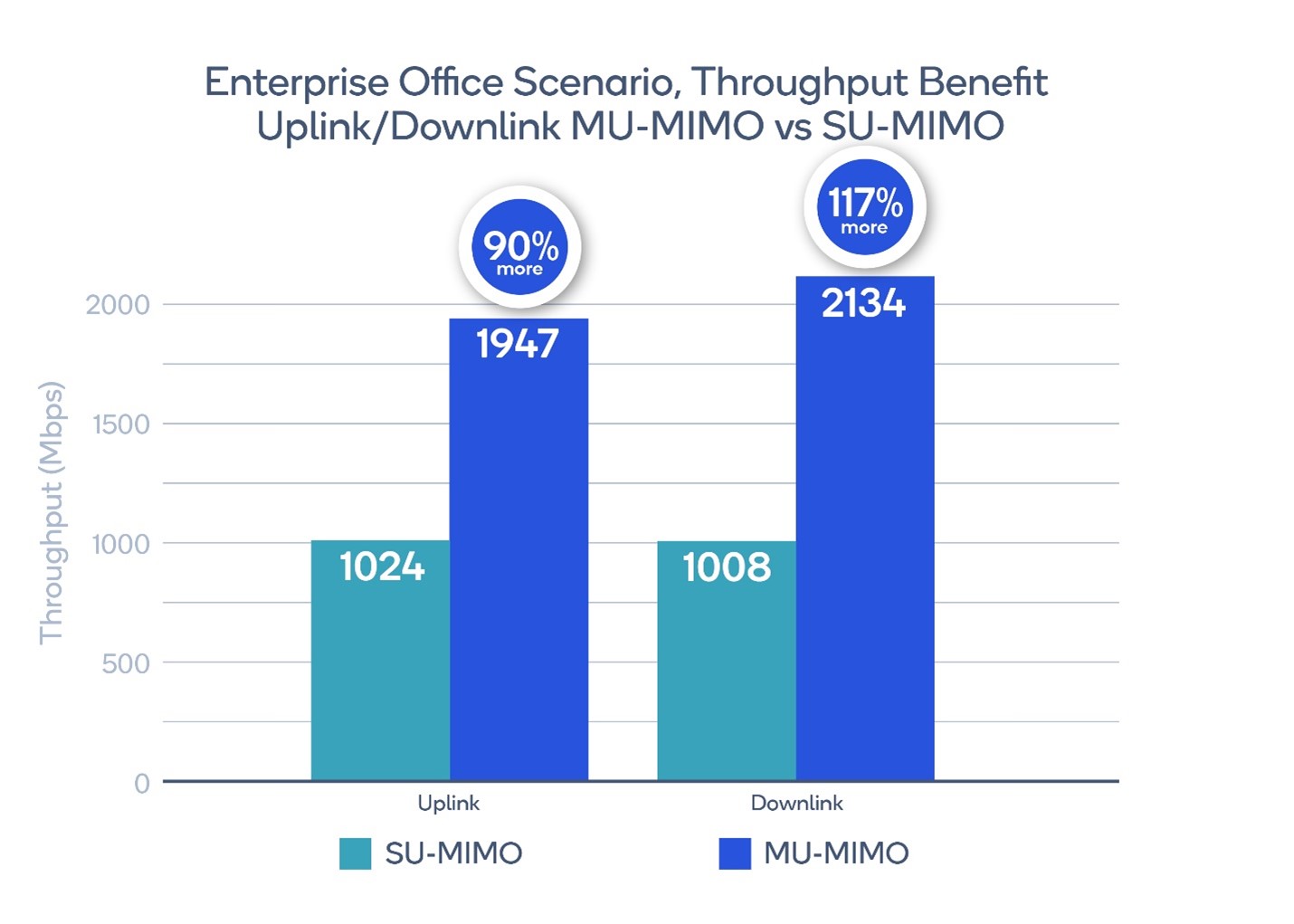One of Wi-Fi’s greatest strengths has been its continuous evolution to meet the needs of every new generation of devices and applications.
Introduced in Wi-Fi 5 and twice enhanced in Wi-Fi 6 releases, multi-user multiple-input, multiple-output (MIMO) technologies are critical to achieving maximum throughput and minimal latencies in today's data-rich homes, enterprises, and public spaces. In 2019, Qualcomm Technologies was among the first to introduce Wi-Fi 6 based uplink multi-user MIMO and recently uplink multi-user MIMO was included as a flagship feature in the Wi-Fi CERTIFIED 6™ Release 2 program.
Multi-user MIMO's ability to increase speed and responsiveness under dynamic conditions will make the difference between digital victories or defeats in crowded spaces, as users of all ages increase their reliance on the quality of their Wi-Fi connections for high-definition video streaming for office conferences, social media sessions, gaming, second screen entertainment, and other usages.
Although fully implementing multi-user MIMO has proved daunting for some Wi-Fi access point (AP) makers due to scheduling and layer management complexities, the benefits have become too important to ignore. Wi-Fi CERTIFIED 6 Release 2 equipment can enable multi-gigabit speeds with aggregated downlink and uplink multi-user MIMO and can leverage orthogonal frequency division multiple access (OFDMA) to reduce latency for time-sensitive applications. However, implementing these Wi-Fi features demands a world-class, intelligent scheduler with cross-layer optimization to effectively schedule multi-user transmissions across spatial streams or frequencies.
Multi-user MIMO allows superior performance in home, enterprise, and education
Across the home, enterprise, and other dense deployment testing environments, robust multi-user MIMO enables multiple users to enjoy markedly superior performance at varying distances compared to Wi-Fi 6 APs that only implement single-user MIMO. Our recent white paper, The Benefits of MU-MIMO for Wi-Fi 6, canvasses these scenarios in detail, showing how a chipset with multi-user MIMO developed by Qualcomm Technologies can deliver up to 2.5 times the throughput of Wi-Fi chips without multi-user MIMO capabilities. Below are just a few examples of various test scenarios within the white paper that showcase the multiplicative performance optimized multi-user MIMO can deliver.
Figure 4.1 Multi-user MIMO Throughput Benefit in Home Networking Scenario,Qualcomm Wi-Fi 6 AP Scheduler
First, in a home testing scenario comparing uplink single-user and multi-user MIMO performance using our AP scheduler, Wi-Fi 6 clients at 10-foot, 35-foot, and 70-foot distances saw substantial benefits: more than twice the throughput at short range, 67 percent more at mid-range, and 33 percent more at far range. For users, this can mean the difference between achieving gigabit or two-gigabit speeds—a considerably better use of today’s wider broadband pipes.
Figure 4.3 Multi-user MIMO Throughput Benefit in Enterprise Office Scenario,Qualcomm Wi-Fi 6 AP Scheduler
We saw similarly strong gains in an enterprise office scenario that contrasted combined downlink and uplink performance of multi-user MIMO with single-user MIMO. Here, a Wi-Fi 6 AP was placed in a standard office setting with four Wi-Fi 6 clients in varied cubicles, using software to simulate several employees downloading or uploading large server files, or a software upgrade rolling out wirelessly to multiple laptops. Once again, total downlink throughput more than doubled, from 1 Gbps to 2.1 Gbps, as did uplink from 1 Gbps to 1.95 Gbps.
Another usage environment that stands to benefit from multi-user MIMO technology is the classroom setting, with several students running heavy traffic on their laptops. Heavy downlink traffic in a classroom can occur if, for example, students are downloading large metadata files for a project assignment or performing a simultaneous software upgrade, or if the instructor is downloading a large presentation file or video.
In the uplink direction, examples include students uploading large files such as those for multimedia assignments or engineering CAD designs. Moreover, high downlink and uplink multi-user MIMO capacity is crucial in the presence of large background traffic from overlapping networks (e.g., nearby classes).
In this scenario, ten Wi-Fi 6 clients were placed in three rows in front of a Qualcomm Wi-Fi 6 AP. In this environment multi-user MIMO experienced throughput gains of 91 percent for uplink multi-user MIMO and 104 percent for downlink multi-user MIMO compared to single-user MIMO transmissions. Higher downlink and uplink Wi-Fi speeds allow for a smooth and efficient experience for both students and instructors.
There is no question that Wi-Fi CERTIFIED 6 Release 2 provides the potential for outstanding real-world wireless connectivity performance—gigabit-class for individual devices and multi-gigabit-class across multiple users.
Qualcomm Wi-Fi 6 is a product of Qualcomm Technologies, Inc. and/or its subsidiaries.
The statements and opinions by each Wi-Fi Alliance member and those providing comments are theirs alone, and do not reflect the opinions or views of Wi-Fi Alliance or any other member. Wi-Fi Alliance is not responsible for the accuracy of any of the information provided by any member in posting to or commenting on this blog. Concerns should be directed to info@wi-fi.org.






Add new comment